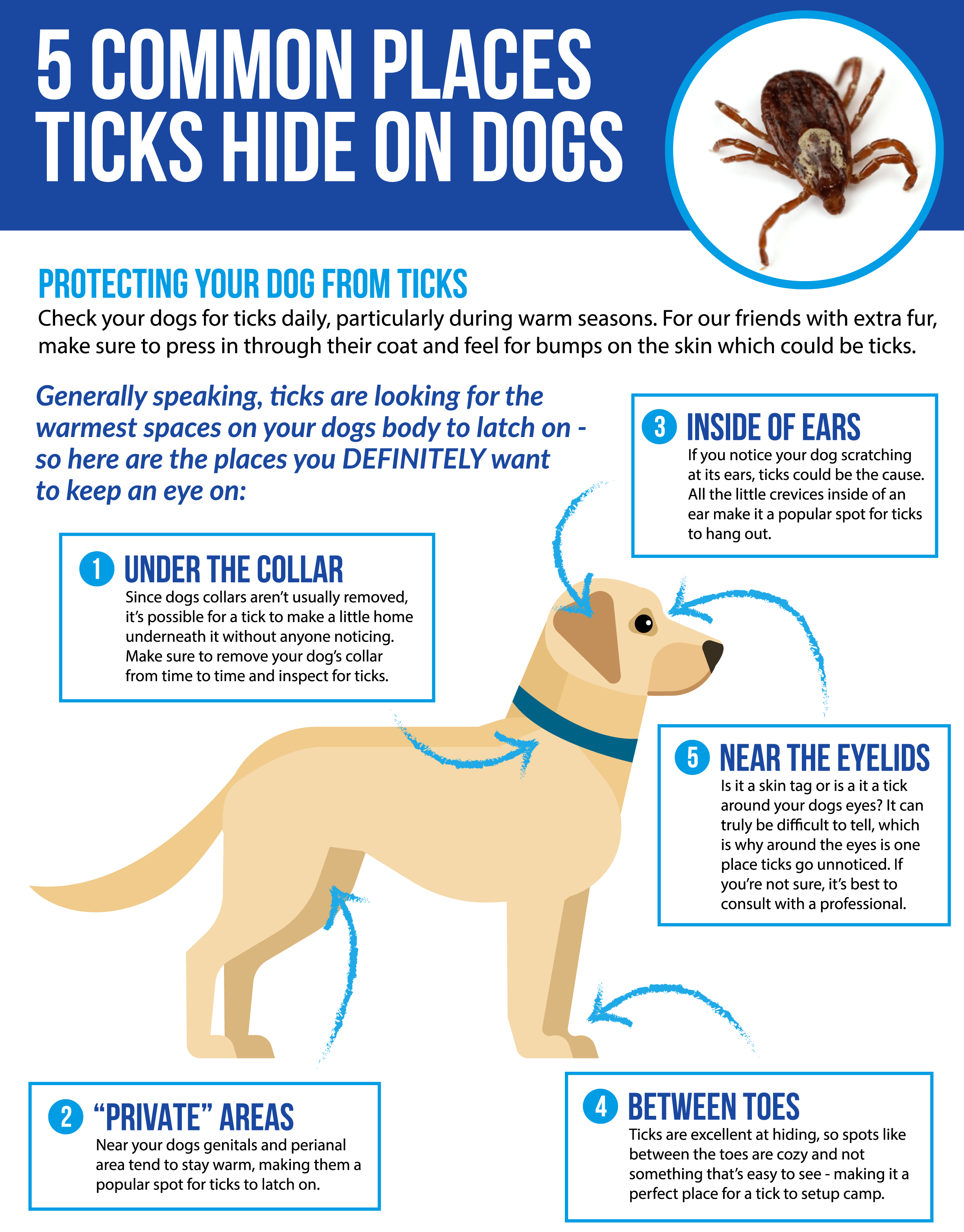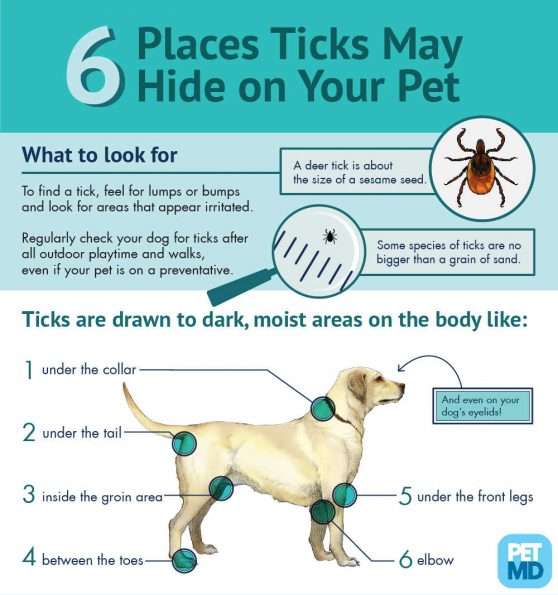Recognize Where Ticks Live
One of the signs of watching for ticks will happen before you even venture out with your pets. Ticks tend to live in tall grass and thick undergrowth. You will also find them in marshlands and wooded areas. Knowing the possible location of ticks allows you to be more vigilant before and after being in those areas.
Always check your pet and yourself before venturing into the woods and immediately after. Doing so will give you the best chance at finding a tick before it can cause damage. Remember to look between toes, around and inside ears, and near and under the tail.
Is Lyme Disease In Dogs Contagious
There are no recorded cases of direct transmission of Lyme disease from dog to human, nor from dog to other animals. The only way of transmitting the bacteria is through a deer tick. But since dogs and owners spend their time in the same places and environments, there is a great possibility for both of them to catch the disease through infected ticks. For humans, it is more likely to develop symptoms, such as the characteristic bulls-eye rash followed by fever, fatigue and joint and muscle pain. If either dog or the owner test positive for Lyme disease or show some symptoms related to the disease, the other one should also consider getting tested.
Lyme Disease Prevention In Dogs
Keeping your pup on tick-prevention medication is one way of keeping them safe from contracting Lyme disease.
As well, whenever you dog has been walking through areas that may serve as a hiding spot for ticks, you should check you pet’s skin and remove any ticks as quickly as possible to reduce the risk of transmitting disease.
That said, removing ticks isn’t as straightforward as you may think. Contact your vet for instruction on how to properly remove ticks from your dog. .
Remember – Lyme disease is much more severe in humans than it is in dogs! If you walk in areas with long grass or shrubs be sure to check your skin regularly for ticks. Contact your doctor for advice on removing ticks if you find one latched onto your skin. Lyme disease in humans can cause a host of painful chronic symptoms.
Note:The advice provided in this post is intended for informational purposes and does not constitute medical advice regarding pets. For an accurate diagnosis of your pet’s condition, please make an appointment with your vet.
Don’t Miss: Full Recovery From Lyme Disease
It’s All Across The Country
Likewise, the nonchalance of the past no longer applies to Lyme’s regional characteristics either.
“It used to be kind of a Northeast, Midwest phenomenon,” explains Dr. Goldstein, “but when you look at the latest maps, it’s all over the country. There’s really almost no state without Lyme. We see quite a bit of Lyme in California, in Florida, in the states that used to be relatively low in the upper West Coast. So, yeah, it’s virtually everywhere and I believe very strongly that every dog in this country should be tested annually.”
If you’re wondering why its footprint is increasing, Dr. Goldstein says to look no further than global warming.
“That has to do with the warming climate,” he tells CBS News. “It has to do with more deer that can transmit ticks from place to place, more mice. Mice are the main reservoir for Lyme and the mice population has exploded over the last few years — again, possibly because of mild winters. Global warming is definitely manifesting itself in tick-borne disease in general and we see that in humans as well as in dogs. We see diseases that exist today in areas that we just didn’t have five and ten years ago.”
How Long Does It Take For A Dog To Show Symptoms Of Lyme Disease

Early symptoms of Lyme disease in dogs can appear anywhere from two to five months after being bitten by an infected tick. Their long incubation period contributes to the confusion that often surrounds diagnosis, as pet parents dont always recall when their dog may have been exposed to areas with ticks. This is another reason to consult your veterinarian as soon as you notice any symptoms.
Once they show symptoms, what happens to a dog with Lyme disease? And how does this disease progress? Left untreated, Lyme disease can be fatal. Advanced Lyme disease in dogs spreads throughout the body. Once it reaches the kidneys, your dog may experience vomiting, weight loss, lethargyand, frequently, death.
Also Check: Can You Get A Test For Lyme Disease
How Do Dogs Get Lyme Disease
Like humans, dogs can contract Lyme disease from ticks, specifically the deer tick, which carry the bacteria that causes the disease. The American Kennel Club notes that the ticks most likely to carry Lyme disease are typically found in forests and woods , marshes, tall grass, and areas with thick brush. In terms of geographical locations, ticks carrying Lyme have been expanding their reach across the United States in recent years, but are most prevalent in the Northeast, upper Midwest, and Pacific Northwest regions.
Dr. Sarah Wooten, veterinarian and American Society of Veterinary Journalists member, tells Pumpkin, When your dog spends time in the woods, marshes, grass, or bushy areas without adequate tick protection on board, these monstrous little bugs can latch on and bite. Those bites can transmit bacteria into your dogs bloodstream that cause Lyme disease, and thats when we have a real problem.
Lyme Affects Some Breeds Worse Than Others
There are a couple of notable exceptions to that rule: Labradors and golden retrievers.
There is a deadly manifestation of Lyme disease in dogs, called Lyme nephritis. It’s a fatal side effect that causes the animal’s kidney to fail, and researchers have a strong suspicion that labs and golden retrievers are predisposed. And because of this, both vets we spoke to agreed that any dogs of these two breeds who test positive for Lyme should be treated with Doxycycline immediately.
Read Also: Signs Of Lyme Disease In People
How To Safely Remove Ticks
Wearing latex gloves can help prevent diseases from spreading. Usingtweezers or a tick-removal instrument, pull the tick out of the dog’sskin using this method.
Only use petroleum jelly to smother the tick so it falls out on itsown will also not work. Don’t attempt with nail polish remover or anyother chemicals.
What Does The Lyme Multiplex Assay Measure
The Lyme Multiplex assay quantifies antibodies directed against specific proteins on the surface of B. burgdorferi at three different stages of the bacterial life cycle. This antibody profile can indicate whether an animal has been recently infected or is chronically infected with B. burgdorferi. It can also be used to monitor protective antibodies after vaccination.
Read Also: How Do You Know If You Get Lyme Disease
Which Antibodies Does The Vaccine From Merial Induce
It is a recombinant vaccine based on Osp A. Vaccinated animals should develop high antibody levels to OspA and maintain negative antibody levels to the remaining two antigens. Infected/non-infected animals can be identified based on OspC and OspF antibody values. Detection of the early Lyme infection stage is possible after using this vaccine.
Lyme Disease In Pets Symptoms And Treatment
Pets infected with Lyme disease may not show any signs for 2-5 months. After that time, typical symptoms include:
- Fever
- Joint swelling
Recurrent lameness also is possible, and the involved extremity may be tender. Inflammation of the joint can last from days to weeks, and may migrate from one extremity to another.
Horses with Lyme disease can develop lameness, joint pain, neurologic disease, eye problems and dermatitis.
Symptomatically, Lyme disease can be difficult to distinguish from anaplasmosis because the signs of the diseases are very similar, and they occur in essentially the same areas of the country. Lyme disease is diagnosed through a blood test that shows whether an animal has been exposed to the bacterium.
Antibiotics usually provide effective treatment for Lyme disease. However, its important to follow your veterinarians advice regarding follow-up care after your pet has been diagnosed with and treated for the disease.
Read Also: Lyme Disease And Chronic Fatigue
Kidney Damage Caused By Lyme Disease
More serious complications, although uncommon, include:
-
Damage to the kidneys
-
Rarely, heart or nervous system disease 1,2
Lyme disease sometimes leads to glomerulonephritisthe inflammation and accompanying dysfunction of the kidney’s glomeruli .
Eventually, kidney failure may set in as the dog begins to exhibit signs such as vomiting, diarrhea, lack of appetite, weight loss, increased urination and thirst, and abnormal fluid buildups that can appear as swollen limbs.
How Can I Prevent My Dog From Getting Lyme Disease

The key to prevention is keeping your dog from being exposed to ticks. Ticks are found in grassy, wooded, and sandy areas. They find their way onto an animal by climbing to the top of a leaf, blade of grass, or short trees, especially cedar trees. Here they wait until their sensors detect an approaching animal on which to crawl or drop. Keeping animals from thick underbrush reduces their exposure to ticks. Dogs should be kept on trails when walked near wooded or tall grass areas. Vaccination against Lyme disease is recommended for pets that live in endemic areas or that travel to areas where Lyme disease is prevalent.
“Vaccination against Lyme disease is recommended for pets that live in endemic areas or that travel to areas where Lyme disease is prevalent.”
Recommended Reading: Dr Nader Soliman Lyme Disease
Arthritis Caused By Lyme Disease
There are many causes for arthritis, and your veterinarian will focus on differentiating arthritis initiated by Lyme disease from other inflammatory arthritic disorders, such as trauma and degenerative joint disease.
Immune-mediated diseases will also be considered as a possible cause of the symptoms. X-rays of the painful joints will allow your doctor to examine the bones for abnormalities.
How To Treat Lyme Disease In Dogs
Lyme disease can be treated in cases where dogs develop symptoms, such as lameness, fever, fatigue, and swollen lymph nodes. Antibiotic treatment with Doxycycline as the first choice is usually conducted for four weeks, despite the quick improvement of the dogs state and symptoms. Additionally, analgesics and other supplements can be given as well, to support the dogs general state. Nevertheless, supervision and retesting should be done for a longer period of time, since recurrent symptoms can occur. To learn more about treatment, check the section ‘Treatment for Lyme Disease in Dogs.’
Read Also: Best Infrared Sauna For Lyme Disease
What To Expect At Home
Home care for dogs with Lyme disease is relatively straightforward. Doxycycline is usually given by mouth twice daily for at least 30 days. Improvement in the dogs symptoms should be noted within 24-48 hours. If the dogs condition fails to improve in 72 hours or worsens at any time, call your veterinarian.
What Are The Clinical Signs Of Lyme Disease
Some people with Lyme disease develop a characteristic bull’s-eye rash at the site of the bite within three to thirty days. If this occurs, the disease can be easily diagnosed at an early stage.
However, signs of Lyme disease are more difficult to detect in animals than in people. The characteristic rash does not develop in dogs or cats. In fact, Lyme disease is practically unheard of in cats.
“Affected dogs have been described as if they were walking on eggshells.”
Many dogs affected with Lyme disease are taken to a veterinarian because they seem to be experiencing generalized pain and have stopped eating. Affected dogs have been described as if they were walking on eggshells. Often these pets have high fevers. Dogs may also begin limping. This painful lameness often appears suddenly and may shift from one leg to another. If untreated, it may eventually disappear, only to recur weeks or months later.
Some pets are infected with the Lyme disease organism for over a year before they finally show symptoms. By this time, the disease may be widespread throughout the body. Non-specific signs which may indicate that Lyme disease is affecting the kidneys include vomiting, lethargy, anorexia , and weight loss. The kidney form of the disease is less common, but often fatal.
You May Like: How To Protect Yourself From Lyme Disease
What Are The Symptoms Of Lyme Disease
Dogs can display several forms of Lyme disease, but the most common symptoms are lameness, swollen lymph nodes, joint swelling, fatigue, and loss of appetite. In addition, serious kidney complications have been associated with Lyme disease in dogs.
Clinical signs of Lyme disease in horses include shifting-leg lameness, generalized stiffness, hypersensitivity to touch, weight loss, and poor performance. Sometimes, the bacteria can infect the central nervous system, leading to neurologic symptoms.
How Lyme Disease Is Transmitted
The question “How is Lyme disease spread?” is asked most often by people who are bitten by infected ticks but do not have signs or symptoms of the illness. Lyme disease is transmitted through a tick’s bite, which is why it is called ” Lyme.” Lyme disease is more prevalent in the western US and parts of Canada, where deer are frequently hunted.Lyme disease can be caused by several different species of ticks, including black-legged ticks and deer tick, but it is primarily transmitted to humans by the black-legged tick, which is easier to transmit because of its small size. The name “Lyme” comes from a town in Connecticut called “Lyme Disease,” where a local epidemic of lyme disease occurred in 1975.
Although antibiotics are available to treat lyme disease, most patients experience recurrence within a few weeks of their initial treatment.This usually occurs because the body’s immune system is not strong enough to fight off the infection. If you are experiencing repeated bites, have a rash, or are experiencing joint pain or swelling, contact your doctor immediately for confirmation that you are infected with Lyme disease. Lyme disease symptoms are usually similar to those of other tick-borne infections, so it is wise to be tested if you think you may have been infected.
Don’t Miss: Is Lyme Disease Curable In Humans
Diagnosis Of Lyme Disease
For the most successful diagnosis, a combination of history, physical examination and signs, together with a diagnostic blood test, is needed. The main reason is the fact that many dogs can test positive on a blood test without showing and developing any symptoms. In this case, they dont necessarily need treatment. Other tests can also be conducted, so diseases with similar symptoms can be ruled out.
Tiny Deer Ticks Transmit Lyme Disease

Although the tick prefers certain creaturessuch as voles, white-footed mice, or deerupon which to feed during the various stages of its life cycle, it is quite willing to feed on people or dogs. Regardless of its stage of development , if the tick carries the bacteria in its body, people and dogs can become infected if bitten. Once a tick attaches, it takes 1-2 days for it to transmit the bacteria that cause Lyme disease, so prompt removal of ticks is important. Risk of transmission is highest during periods when the nymphs and adults are actively seeking hosts.
Lyme disease in dogs has been reported in every state in the United States, but certain geographical areas are much more likely to harbor bacteria-carrying ticks than others. Infection rates of ticks vary, but can be as high as 50%. Areas in the United States where it occurs most often include the northeast , upper Midwest, and Pacific coast. The disease is actually named after the town Lyme, Connecticut, where an early outbreak was first described. Lyme disease is also seen in Europe and Asia. The risk of Lyme disease being transmitted to people is increasing. In the last 20 years, the number of cases reported to the Centers for Disease Control has about doubled, to around 30,000/year. Although the rate of occurrence of the disease in a geographic area is similar in both animals and people, animals, especially dogs, are at significantly higher risk because of their greater exposure to ticks.
You May Like: How To Get Rid Of Lyme Disease In Humans
Things You Need To Know About Lyme Disease In Dogs
May 4, 2017 / 4:49 PM / CBS News
The arrival of springtime means Lyme disease is again resurfacing as a concern on the radar screens of people across the country. So, if you go for a hike or take a walk through long grass, chances are that you’ll check yourself for ticks afterward.
But our pets are constantly lounging and playing in conditions conducive to tick exposure, and how often do we thoroughly check them? If the answer to that question isn’t “every day,” then experts say it’s not enough.
“The most important thing is to stress prevention,” explains Dr. Richard Goldstein, chief medical officer at New York City’s Animal Medical Center. “This is something that we want to prevent from happening the first time. Once you’re infected with these organisms, the chance is you might be infected for life. So, you just have to really go through hair by hair. Look at the paws. Look at the ears. Look around the muzzle, the face. If you do it every day, you’re not going to get a big accumulation.”
Occasionally, however, a dog can pick up hundreds of ticks on a single outing and the result can be disgusting, to say the least.
“Sometimes if a dog walks through a place where ticks were molting into nymphs, you might find 200 tiny ticks on your dog,” explains Dr. Goldstein. “That’s scary when that happens.”
But that’s not the only scary reality of Lyme that pet owners should heed.